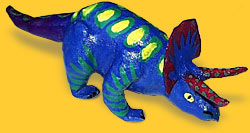

 Paper
Maché Dinosaur Sculpture
Paper
Maché Dinosaur Sculpture
John
Payne combines science and art to create life-size, moving dinosaur
sculptures called kinetosaurs. Read about the methods this artist
uses to create his kinetosaurs. Then create your own dinosaur
sculpture with paper maché. See the online demonstration of
this project for hints.
You will need:
1. Select and research a dinosaur. Find out as much as you can about your chosen dinosaur. Learn as much as you can about its anatomy to build your sculpture.
2. Make sketches of your dinosaur sculpture. Plan its pose. What is it doing? Draw an outline.

What are the basic shapes of your dinosaur? Highlight the forms that
you will make from newspaper.

3. Make body parts with newspaper, cardboard and masking tape. Crush, squeeze and twist newpaper into very tight forms. Cut flat shapes from cardboard. Tape firmly as you go! Make sure your pieces are smooth and very firm. Rub the tape so no edges come loose.

4. Tape the body parts together. Use lots of tape and rub it hard to be sure it won't come off. Tape all the way around each body part&emdash;layer the tape in different directions. You may have to tear the tape into small pieces to get in the tiny seams. Test the body parts to make sure they don't come off easily.

5. Time to paper maché! Find a place to work. Cover your work space with newspaper. Prepare your paper maché paste. Have a towel handy to wipe your hands. Tear lots of small strips of newspaper--no bigger than your finger. For very small, detailed parts you will need even smaller strips.

Dip each newspaper strip in your paste. Then pull strip through two fingers to remove excess paste. You want them wet but not drippy and slimy.


Cover
the body with newspaper strips. Rub them well so no edges pop up. Rub
out all air bubbles too!

Allow to dry. Do another layer of newspaper strips and dry. Do one more final coat with paper towels (brown "school" paper towels work great!) or smooth, soft paper.

You are ready to paint when your dinosaur is sturdy and smooth. Let it dry very thoroughly!

6. Paint with tempera paint. First, you may want to try out different colors and patterns by coloring your sketch with crayons or colored pencils.
Paint the main colors first, recoat if needed, then paint the details and patterns.
You
may also want to coat with a clear, water-based, non-toxic "varnish"
(Mod Podge Gloss Lustre, Rightstep Water-Based Varnish or watered
down white glue). 
7. Display your sculpture. Plan how will it be displayed (free-standing, on a stand, hanging?) You may want to include a short paragraph about your dinosaur.